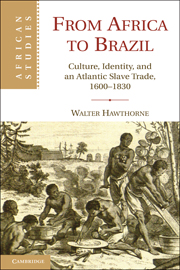Book contents
- Frontmatter
- Contents
- List of Figures
- List of Maps
- List of Tables
- Abbreviations Used in Notes
- Acknowledgments
- Introduction
- PART I THE WHY AND HOW OF ENSLAVEMENT AND TRANSPORTATION
- PART II CULTURAL CHANGE AND CONTINUITY
- 4 Labor over “Brown” Rice
- 5 Violence, Sex, and the Family
- 6 Spiritual Beliefs
- Conclusion
- Index
- References
Conclusion
Published online by Cambridge University Press: 05 September 2012
- Frontmatter
- Contents
- List of Figures
- List of Maps
- List of Tables
- Abbreviations Used in Notes
- Acknowledgments
- Introduction
- PART I THE WHY AND HOW OF ENSLAVEMENT AND TRANSPORTATION
- PART II CULTURAL CHANGE AND CONTINUITY
- 4 Labor over “Brown” Rice
- 5 Violence, Sex, and the Family
- 6 Spiritual Beliefs
- Conclusion
- Index
- References
Summary
This book is one of a handful of studies about Upper Guineans in diaspora and is the only book-length examination of African slavery in Maranhão before the early nineteenth century. In it, I have traced the flow of tens of thousands of Upper Guineans from their points of capture, to the ports of Bissau and Cacheu, across the Atlantic to the ports of São Luís and Belém, and finally onto Brazilian plantations. I have explored the reasons planters in the Amazonian captaincies of Maranhão and Pará demanded African slaves. This was because Indian slaves died in tremendous numbers from European diseases and because the state’s encouragement of rice and cotton production in the late eighteenth century brought planters enough capital to afford the import of Africans. Africans, planters thought, were “more robust and capable” than Indians. Also, I have argued that the reason Upper Guineans – as opposed to people from other regions of Africa – came to comprise a majority on most Maranhense plantations can be attributed to the nature of Atlantic winds and currents and to policies aimed at strengthening Portugal’s hold on the African ports of Bissau and Cacheu. Policies linking these ports to São Luís, it was thought, would bolster Portuguese efforts on both sides of the ocean.
Turning my attention to the hundreds of thousands of Upper Guineans whose lives were affected by the Atlantic demand for slaves, I have made two broad arguments. First, I have asserted that inventories recording ethnonyms of slaves in the New World can be used to show with great specificity from where slaves hailed within the Old World. With data from inventories recorded in Maranhão, I have challenged long-standing assumptions that scholars have made about slave production in Upper Guinea. Most slaves exported from the ports of Cacheu and Bissau were not usually transported over long distances from the African interior and were not often the products of large-scale wars among states. Rather, they were enslaved through small-scale raids, kidnappings, and witchcraft trials that occurred in Upper Guinea’s politically decentralized coastal zone. Slaves exported through Bissau and Cacheu most often came from places tens – not hundreds – of miles from these ports.
- Type
- Chapter
- Information
- From Africa to BrazilCulture, Identity, and an Atlantic Slave Trade, 1600–1830, pp. 248 - 254Publisher: Cambridge University PressPrint publication year: 2010



